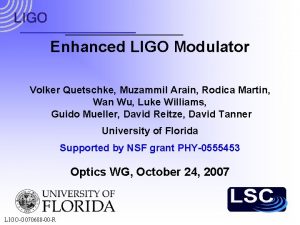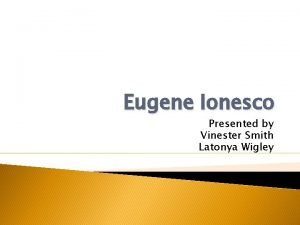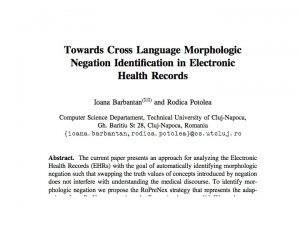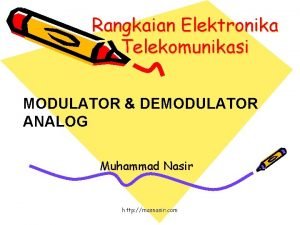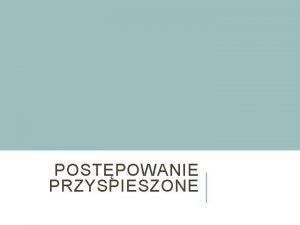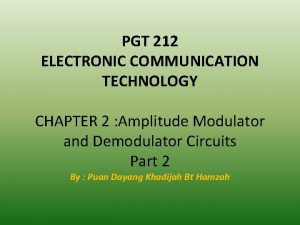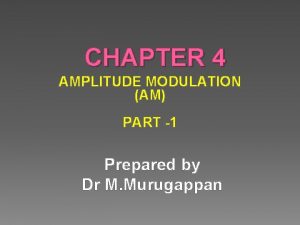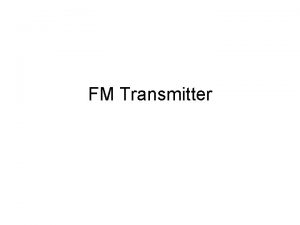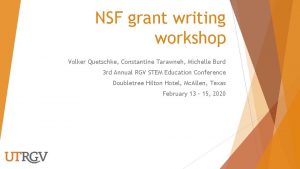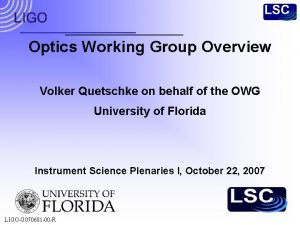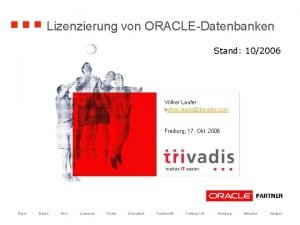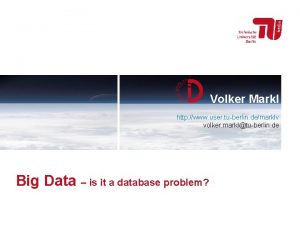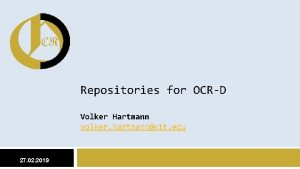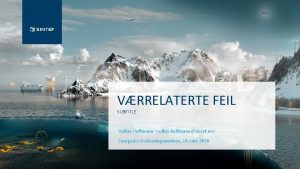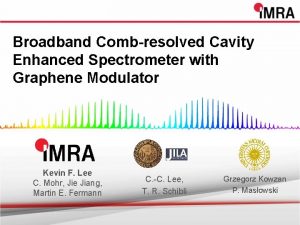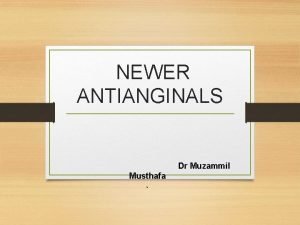Enhanced LIGO Modulator Volker Quetschke Muzammil Arain Rodica














- Slides: 14

Enhanced LIGO Modulator Volker Quetschke, Muzammil Arain, Rodica Martin, Wan Wu, Luke Williams, Guido Mueller, David Reitze, David Tanner University of Florida Supported by NSF grant PHY-0555453 Optics WG, October 24, 2007 LIGO-G 070680 -00 -R

e. LIGO phase modulator LIGO is currently being upgraded to e. LIGO Laser power will be increased to 30 W Electro-optic modulators (EOMs) must be replaced. – Li. Nb. O 3 modulators would suffer from severe thermal lensing or might even break e. LIGO devices (techniques) will be used in Adv. LIGO-G 070680 -00 -R

Overview e. LIGO EOMs – Lithium niobate (Li. Nb 03), used in initial LIGO, not satisfactory • Thermal lensing / Damage / Residual absorption – Choose RTP (rubidium titanyl phosphate - Rb. Ti. OPO 4) as EO material • RTP has significantly lower absorption and therefore thermal lensing. – Use custom made housing to separate the crystal housing from the housing for the resonant circuit. Advantage: Resonant frequencies can be changed without disturbing the optical alignment. – Use wedged crystals to reduce spurious amplitude modulation Additional advantage: EOM acts as polarizer LIGO-G 070680 -00 -R

Wedged RTP crystal Wedged crystal separates the polarizations and acts as a polarizer. – This avoids cavity effects and reduces amplitude modulation. Polarization Angle [degrees] AR coatings (< 0. 1%) on crystal faces. 7 mm LIGO-G 070680 -00 -R p 4. 81 s 4. 31 22 mm 7 mm

Three Modulations / Single Crystal design Use one crystal but three separate pairs of electrodes to apply three different modulation frequencies at once. Electrodes: – 7 mm – 22 mm – 7 mm LIGO-G 070680 -00 -R

Industry-quality housing Separate the crystal housing from the housing of the electronic circuits to maintain maximum flexibility. LIGO-G 070680 -00 -R

Resonant circuit Impedance matching circuit in separate housing. Resonant circuit with 50 Ω input impedance. Current version at Cal. Tech has three resonant circuits: – 24. 5 / 33. 0 / 61. 2 MHz LIGO-G 070680 -00 -R

Modulation index measurement Electrodes driven with 24 d. Bm (10 Vpp) yield: – m 24. 5 = 0. 37 – m 61. 2 = 0. 14 – m 33. 0 = 0. 14 LIGO-G 070680 -00 -R

Thermal properties Use a YLF laser was used to measure thermal lensing. – Full Power = 42 W – Beam Waist = 0. 5 mm (at RTP) – 4 x 4 x 40 mm RTP crystal Axis Focal length X-axis 3. 8 m Y-axis 4. 8 m compare with Li. Nb. O 3 (20 mm long): fthermal ~ 3. 3 m @ 10 W LIGO-G 070680 -00 -R

RFAM Wedged geometry suppresses amplitude modulation. (No polarisation rotation possible) – Cursory result for the current version: DI/I < 10 -5 at Wmod = 25. 4 MHz / m = 0. 17 Final characterization underway – Including RFAM at high power (30 W) levels. LIGO-G 070680 -00 -R

What is left to do? Continue testing at Cal. Tech with 30 W e. LIGO laser – – RFAM Thermal lensing Long-term stability EMI Start 200 W (Adv. LIGO) testing. . . – Next week. . . LIGO-G 070680 -00 -R

Supplementary material LIGO-G 070680 -00 -R

RTP Thermal properties Properties Units RTP RTA KTP Li. Nb 03 dnx/d. T dny/d. T dnz/d. T 10 -6/K W/Km cm-1 1/W 1/W 2. 79 9. 24 3 3 3 < 0. 0005 0. 047 0. 15 5. 66 11. 0 11 13 16 2 3 3 < 0. 005 2. 2 2. 7 5. 4 37. 9 5. 6 < 0. 05 4. 8 34 kx ky kz a Qx Qy Qz LIGO-G 070680 -00 -R < 0. 005 0. 94 1. 83

Optical and electrical properties Properties Units/conditions Damage Threshold MW/cm 2, nx 1064 nm ny 1064 nm nz 1064 nm Absorption coeff. a cm-1 (1064 nm) r 33 pm/V r 23 pm/V r 13 pm/V r 42 pm/V r 51 pm/V r 22 pm/V nz 3 r 33 pm/V Dielectric const. , ez 500 k. Hz, 22 o. C Conductivity, sz W-1 cm-1, 10 MHz Loss Tangent, dz 500 k. Hz, 22 o. C LIGO-G 070680 -00 -R RTP >600 1. 742 1. 751 1. 820 < 0. 0005 39. 6 17. 1 12. 5 ? ? RTA 400 1. 811 1. 815 1. 890 < 0. 005 40. 5 17. 5 13. 5 ? ? 239 30 ~10 -9 1. 18 273 19 3 x 10 -7 - Li. Nb. O 3 280 2. 23 2. 16 < 0. 005 30. 8 8. 6 28 28 3. 4 306
